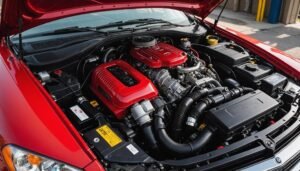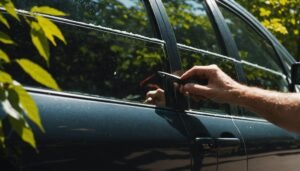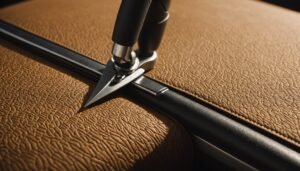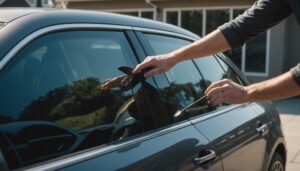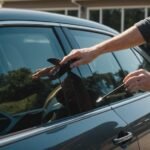Replacing your car’s headliner fabric can seem challenging, but it’s a task you can tackle with the right approach. Start by gathering your tools and materials, as this will streamline the process. Removing the old headliner requires care, so pay attention to how everything comes apart. Once that’s done, you’ll need to clean up and prepare the surface. The next steps are vital to achieving a professional finish that lasts.
Key Takeaways
- Remove the old headliner by gently pulling down the fabric and detaching any trim pieces securing it in place.
- Clean the surface thoroughly, removing leftover glue and inspecting the backing board for any damage.
- Cut the new fabric to size, ensuring to measure accurately and allowing extra inches for proper coverage.
- Apply adhesive in sections and smooth out any bubbles, ensuring the fabric lies flat on the headliner board.
- Reattach the headliner board to the vehicle’s roof using original fasteners, checking alignment and trimming excess fabric as needed.how-much-is-urgent-care-without-insurance
Gather Your Tools and Materials
Gathering your tools and materials is essential to a smooth headliner replacement. First, you’ll need safety goggles and gloves to protect yourself during the process.
Then, grab a sharp utility knife or pair of scissors for cutting the new fabric. You’ll also want a staple gun and staples for securing the new headliner, along with adhesive spray for extra hold.
Don’t forget a paintbrush or roller to apply the adhesive evenly. A straight edge or ruler guarantees your cuts are precise, while a measuring tape guarantees you get the correct amount of fabric.
You’ll also need a clean workspace, preferably with good lighting, so you can see what you’re doing.
Finally, having a garbage bag on hand will make cleanup easier as you go. With all your tools and materials gathered, you’re ready to jump into the replacement process!how-fast-do-f1-cars-go
Remove the Old Headliner
Start by carefully removing the old headliner from your car’s interior.
Begin at one corner and gently pull down the fabric. Be cautious, as you don’t want to damage any clips or attachments. Use your hands or a flat tool to aid in the removal, if necessary.
Work your way around the perimeter, detaching any trim pieces that may be holding the headliner in place. If you encounter stubborn areas, check for hidden fasteners or adhesive that might be securing it.
Once the edges are free, slowly peel the headliner away from the roof.
Take your time to avoid tearing it, as you may need it as a template for the new fabric. Make sure to remove any leftover foam or adhesive from the old headliner.
Once you’ve fully detached it, dispose of the old fabric responsibly to keep your workspace tidy.
Prepare the Surface
Before installing the new headliner fabric, you need to prepare the surface to guarantee a smooth application. Start by cleaning the area thoroughly. Remove any residual glue, dirt, or debris to affirm proper adhesion.
You might also want to check for damage to the backing board, as this can affect the final look of your headliner.how-to-check-oil-in-car
Here are some key preparation steps:
- Clean the Old Surface: Use a brush or cloth to remove any dust and dirt.
- Remove Old Adhesive: Scrape off any leftover glue with a putty knife.
- Inspect for Damage: Look for cracks or weak spots in the backing board.
- Sand Rough Areas: Lightly sand uneven surfaces to create a smooth finish.
- Dry the Surface: Make sure everything is dry before proceeding with the installation.
Taking these steps will affirm a professional-looking result when you apply your new fabric.
Cut and Apply New Fabric
Once you’ve confirmed that the surface is properly prepared, it’s time to cut and apply the new fabric for your headliner. Start by measuring the area accurately with a tape measure. You’ll want to leave a few extra inches on each side to guarantee full coverage.
Once you’ve got your measurements, transfer them onto the fabric, marking where you need to cut. Use sharp fabric scissors for a clean edge.
Next, spread the fabric out over the board, making sure it lays flat without wrinkles. Carefully position it, then fold the extra edges over the sides of the board. This extra material will help with adhesion.
Apply a high-quality automotive adhesive to the board’s surface in sections, sticking the fabric down firmly as you go. Make sure to smooth out any bubbles or wrinkles with your hands or a smoothing tool.
Let it set for the recommended time before moving on to the next step.
Reattach the Headliner Board
Reattaching the headliner board is an essential step in restoring your car’s interior. Once your new fabric is securely in place, it’s time to bring the headliner board back up.how-long-does-it-take-to-charge-a-car-battery
Start by carefully aligning the board with your vehicle’s roof. Here are some key points to keep in mind:
- Securely fasten: Use the original clips or any necessary fasteners to hold the board firmly.
- Check alignment: Verify the board is level and flush against the roof.
- Avoid sagging: Press down evenly to prevent any areas from bulging or sagging.
- Inspect for gaps: Make sure there are no visible gaps between the board and the car’s interior.
- Final touch: Confirm everything’s tucked away and neat for a polished look.
Following these steps will help guarantee your headliner board is reattached properly, enhancing the overall aesthetic of your vehicle’s interior.
Trim Excess Fabric
Now that you’ve securely reattached the headliner board, it’s time to trim the excess fabric for a clean finish.
Start by using a sharp utility knife or fabric scissors to carefully cut away any extra material. Hold the blade at a slight angle, ensuring you don’t cut into the headliner itself. Follow the edge of the board as a guide, making smooth, controlled cuts for accuracy.
If your headliner has any curves or corners, take your time and work slowly to avoid jagged edges. After you’ve trimmed the bulk of the fabric, inspect the edges.
You might want to make minor adjustments for a neat appearance, especially around the visors and other fittings. Once you’ve achieved the desired look, gently press the fabric down around the edges to secure everything in place.
This attention to detail will give your car interior a polished, professional finish.
Finish With Adhesive
With the excess fabric trimmed away for a neat edge, you’re ready to finish the job with adhesive. Start by choosing a high-quality spray adhesive specifically designed for automotive fabrics. Apply an even coat to both the headliner and the fabric, guaranteeing you cover all edges.how-to-get-cigarette-smell-out-of-car
Here are some tips to make this process easier:
- Work in a well-ventilated area to avoid inhaling fumes.
- Use a roller or brush to keep the fabric smooth and free of bubbles.
- Start from the center, pressing outward to guarantee good adhesion.
- Allow adequate drying time as per the adhesive instructions.
- Check alignment frequently so the fabric sits properly on the headliner.
Once the adhesive has set, you’ll have a freshly updated headliner ready for reinstallation. Enjoy your hard work, and admire how great your car looks inside!
Reinstall Headliner Components
It’s time to reinstall the headliner components and restore your car’s interior. Start by carefully positioning the headliner back into place, ensuring all edges align with the vehicle’s structure.
Next, insert the retaining clips and screws that you removed earlier; this helps secure the headliner firmly. If your vehicle has sun visors, grab those and reattach them by sliding them back into their designated brackets.
Don’t forget the overhead console and any lights; these should snap or screw back into their original spots easily. Once everything is in place, check for any loose areas or wrinkles in the fabric, and adjust them accordingly.
Finally, step back and admire your hard work—your car’s interior should now look fresh and new! Remember to keep the tools handy in case you need to make any last-minute tweaks.
Frequently Asked Questions
How Long Does the Headliner Replacement Process Typically Take?
The headliner replacement process typically takes anywhere from two to four hours, depending on your experience and the vehicle type.
If you’re doing it yourself, factors like preparation and any additional repairs can extend the time.
However, if you’re outsourcing the work to a professional, the time may be closer to the lower end of that range.
Can I Use Any Type of Fabric for the Headliner?
You can’t use just any type of fabric for the headliner; it needs to be lightweight and breathable.
Many people choose upholstery fabrics designed specifically for automotive use. These materials often have the right texture and durability to withstand temperature changes and moisture inside the car.
What Should I Do if the Headliner Board Is Damaged?
If the headliner board’s damaged, you’ll need to assess the extent of the damage.
Minor cracks or chips can often be repaired with glue or epoxy. For larger damage, consider replacing the board entirely.how-fast-do-nascar-cars-go
You can find replacement boards at auto parts stores or online. Make certain to match the size and shape of your original board to guarantee proper fitment.
Once repaired or replaced, you can then reattach your headliner fabric.
Is Professional Help Recommended for Complicated Headliner Designs?
Yes, professional help is often recommended for complicated headliner designs.
You want to guarantee a perfect fit and finish, especially with intricate patterns or features.
Professionals have the right tools and experience to handle these challenges, preventing potential damage to your vehicle.
While DIY can be rewarding, complicated designs can lead to frustration and subpar results.
If you’re unsure, it’s best to consult with an expert who can provide the quality you’re looking for.
How Do I Clean up Excess Adhesive After Installation?
To clean up excess adhesive after installation, grab a solvent like rubbing alcohol or adhesive remover.
Apply a small amount to a clean cloth and gently rub the affected area until the residue dissolves. Be careful not to damage the fabric.
If stubborn spots remain, you might need to repeat the process.
Once you’re done, wipe the surface clean with a dry cloth and let everything cure properly before using your vehicle again.how-to-get-smoke-smell-out-of-car
Conclusion
Replacing your car’s headliner fabric might seem intimidating, but with the right tools and a bit of patience, you can do it yourself. By following the steps to remove the old headliner, clean the surface, and apply new fabric, you’ll restore your vehicle’s interior look. Don’t forget to reattach everything securely and trim any excess fabric. With your new headliner in place, your car will feel fresh and revitalized in no time!


